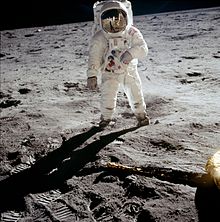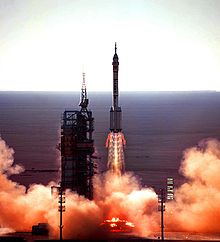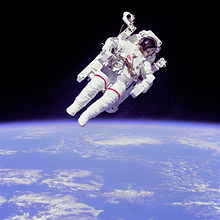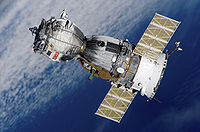- Human spaceflight
-
Orbital Human spaceflight Name Debut Launches Vostok 1961 6 Mercury 1962 4 Voskhod 1964 2 Gemini 1965 10 Soyuz 1967 110 Apollo/Skylab 1968 15 Shuttle 1981 135 Shenzhou 2003 3 Suborbital human spaceflight Name Debut Flights Mercury 1961 2 X-15 1962 13 or 2 (Soyuz 18a) 1975 1 SpaceShipOne 2004 3 Human spaceflight is spaceflight with humans on the spacecraft. When a spacecraft is manned, it can be piloted directly, as opposed to machine or robotic space probes and remotely-controlled satellites.
The first human spaceflight was accomplished on April 12, 1961 by Soviet cosmonaut Yuri Gagarin. The only countries to have independent human spaceflight capability are Russia and China. As of 2011, human spaceflights are being actively launched by the Soyuz programme conducted by the Russian Federal Space Agency and the Shenzhou program conducted by the China National Space Administration.
The US lost human spaceflight launch capability upon retirement of the Space Shuttle on July 21, 2011. Under the Bush administration, the Constellation program included plans for canceling the Shuttle and replacing it with the capability for spaceflight beyond low Earth orbit. In the 2011 United States federal budget, the Obama administration proposed canceling Constellation in part due to Constellation being over budget and behind schedule while not innovating and investing in critical new technologies.[1] Under the new plan, NASA would rely on transportation services provided by the private sector, such as Space X's Falcon 9. The period between the retirement of the Shuttle and the initial operational capability of new systems (either Constellation or the new commercial proposals), similar to the gap between the cancellation of Apollo and the first Space Shuttle flight, is often referred to as the human spaceflight gap.
In recent years there has been a gradual movement towards more commercial forms of spaceflight. A number of non-governmental startup companies have sprung up in recent years, hoping to create a space tourism industry. For a list of such companies, and the spacecraft they are currently building, see List of private spaceflight companies. NASA has also tried to stimulate private spaceflight through programs such as Commercial Crew Development (CCDev) and Commercial Orbital Transportation Services (COTS). With its 2011 budget proposals released in early February 2010,[2] the Obama administration is moving towards a model where commercial companies would supply NASA with transportation services of both crew and cargo to low Earth orbit. The vehicles used for these services would then serve both NASA and potential commercial customers. NASA intends to spend $6 billion in the coming years to develop commercial crew vehicles, using a model similar to that used under COTS.[3]
Contents
History
Main article: History of spaceflightFirst human spaceflights
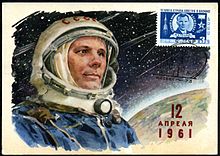 Yuri Gagarin, the first human in space
Yuri Gagarin, the first human in space
The first human spaceflight took place on April 12, 1961, when cosmonaut Yuri Gagarin made one orbit around the Earth aboard the Vostok 1 spacecraft, launched by the Soviet space program and designed by the rocket scientist Sergey Korolyov. Valentina Tereshkova became the first woman in space on board Vostok 6 on June 16, 1963. Both spacecraft were launched by Vostok 3KA launch vehicles. Alexei Leonov made the first spacewalk when he left the Voskhod 2 on March 8, 1965. Svetlana Savitskaya became the first woman to do so on July 25, 1984.
The United States became the second nation to achieve manned spaceflight, with the suborbital flight of astronaut Alan Shepard aboard Freedom 7, carried out as part of Project Mercury. The spacecraft was launched on May 5, 1961 on a Redstone rocket. The first U.S. orbital flight was that of John Glenn aboard Friendship 7, which was launched February 20, 1962 on an Atlas rocket. Since 1981 the U.S. has conducted all its human spaceflight missions with reusable Space Shuttles. Sally Ride became the first American woman in space in 1983. Eileen Collins was the first female Shuttle pilot, and with Shuttle mission STS-93 in July 1999 she became the first woman to command a U.S. spacecraft.
The People's Republic of China became the third nation to achieve human spaceflight when Yang Liwei launched into space on a Chinese-made vehicle, the Shenzhou 5, on October 15, 2003. The flight made China the third nation to have launched its own manned spacecraft using its own launcher. Previous European (Hermes) and Japanese (HOPE-X) domestic manned programs were abandoned after years of development, as was the first Chinese attempt, the Shuguang spacecraft.
The farthest destination for a human spaceflight mission has been the Moon. The only manned missions to the Moon have been those conducted by NASA as part of the Apollo program. The first such mission, Apollo 8, orbited the Moon but did not land. The first Moon landing mission was Apollo 11, during which—on July 20, 1969—Neil Armstrong and Buzz Aldrin became the first people to set foot on the Moon. Six missions landed in total, numbered Apollo 11–17, excluding Apollo 13. Altogether twelve men walked on the Moon, the only humans to have been on an extraterrestrial body. The Soviet Union discontinued its program for lunar orbiting and landing of human spaceflight missions on June 24, 1974 when Valentin Glushko became General Designer of NPO Energiya.[4]
The longest single human spaceflight is that of Valeriy Polyakov, who left earth on January 8, 1994, and did not return until March 22, 1995 (a total of 437 days 17 hr. 58 min. 16 sec. aboard). Sergei Krikalyov has spent the most time of anyone in space, 803 days, 9 hours, and 39 seconds altogether. The longest period of continuous human presence in space is over 10 years, 10 months on the International Space Station. The previous record for MIR was 3,644 days, eight days short of 10 years, spanning the launch of Soyuz TM-8 on September 5, 1989 to the landing of Soyuz TM-29 on August 28, 1999.
For many years beginning in 1961, only two countries, the USSR (later Russia) and United States, had their own astronauts. Citizens of other nations flew in space, beginning with the flight of Vladimir Remek, a Czech, on a Soviet spacecraft on March 2, 1978. As of 2010[update], citizens from 38 nations (including space tourists) have flown in space aboard Soviet, American, Russian, and Chinese spacecraft.
Space programs
As of 2011, human spaceflight missions have been conducted by the former Soviet Union/(Russian Federation), the United States, the People's Republic of China and by the private spaceflight company Scaled Composites.
Several other countries and space agencies have announced and begun human spaceflight programs by their own technology, including India (ISRO), Ecuador (EXA), Japan (JAXA), Iran (ISA) and Malaysia (MNSA).
Currently the following spacecraft and spaceports are used for launching human spaceflights:
- Soyuz with Soyuz rocket—Baikonur Cosmodrome
- International Space Station (ISS)—Assembled in orbit; crews transported by previous spacecraft
- Shenzhou spacecraft with Long March rocket—Jiuquan Satellite Launch Center
Historically, the following spacecraft and spaceports have also been used for human spaceflight launches:
- Vostok—Baikonur Cosmodrome
- Mercury—Cape Canaveral Air Force Station
- Voskhod—Baikonur Cosmodrome
- X-15—Edwards Air Force Base,[5] (two internationally recognized suborbital flights in program)
- Gemini—Cape Canaveral Air Force Station
- Apollo—Kennedy Space Center (Apollo 7 at Cape Canaveral Air Force Station)
- Salyut space station—Baikonur Cosmodrome
- Almaz space station—Baikonur Cosmodrome (Almaz was a series of military space stations under cover of the civilian name Salyut)
- Skylab space station—Kennedy Space Center
- Mir space station—Baikonur Cosmodrome
- SpaceShipOne with White Knight—Mojave Spaceport
- Space Shuttle—Kennedy Space Center
Numerous private companies attempted human spaceflight programs in an effort to win the $10 million Ansari X Prize. The first private human spaceflight took place on June 21, 2004, when SpaceShipOne conducted a suborbital flight. SpaceShipOne captured the prize on October 4, 2004, when it accomplished two consecutive flights within one week. SpaceShipTwo, launching from the carrier aircraft White Knight Two, is planned to conduct regular suborbital space tourism.
Most of the time, the only humans in space are those aboard the ISS, whose crew of six spends up to six months at a time in low Earth orbit.
NASA and ESA now use the term "human spaceflight" to refer to their programs of launching people into space. Traditionally, these endeavors have been referred to as "manned space missions."

National spacefaring attempts
Nation/Organization Space agency Term(s) for space human First launched astronaut Date Spacecraft Launcher Type  Union of Soviet Socialist Republics
Union of Soviet Socialist Republics
(1922–1991)Soviet space program
(OKB-1 Design Bureau)космонавт (Russian)
kosmonavt
cosmonautYuri Gagarin April 12, 1961 Vostok spacecraft Vostok Orbital  Russian Federation
Russian Federation
(1991-)Russian Federal Space Agency космонавт (Russian)
kosmonavt
cosmonaut
spaceflight participant" " Soyuz Soyuz rocket Orbital  United States of America
United States of America
(1776-)National Aeronautics and Space Administration (NASA) astronaut
spaceflight participantAlan Shepard May 5, 1961 Mercury spacecraft Redstone Suborbital  United States of America
United States of America
(1776-)National Aeronautics and Space Administration (NASA) astronaut
spaceflight participantJohn Glenn February 20, 1962 Mercury spacecraft Atlas LV-3B Orbital  People's Republic of China
People's Republic of China
(1949-)Space program of the People's Republic of China 宇航员 (Chinese)
yǔhángyuán
航天员 (Chinese)
hángtiānyuán
taikonaut... 1973 (abandoned) Shuguang 1 Long March 2A  People's Republic of China
People's Republic of China
(1949-)Space program of the People's Republic of China 宇航员 (Chinese)
yǔhángyuán
航天员 (Chinese)
hángtiānyuán... 1981 (abandoned) Piloted FSW Long March 2  European Union
European Union
(1952-)CNES / European Space Agency (ESA) spationaute (French)
astronaut... 1992 (abandoned) Hermes Ariane V  Ba'athist Iraq
Ba'athist Iraq
(1968-2003)[6]... رجل فضاء (Arabic)
rajul faḍāʼ
رائد فضاء (Arabic)
rāʼib faḍāʼ
ملاح فضائي (Arabic)
mallāḥ faḍāʼiy... 2001 (abandoned) ... Tammouz 2 or 3  State of Japan
State of Japan
(1947-)National Space Development Agency of Japan (NASDA) 宇宙飛行士 (Japanese)
uchūhikōshi... 2003 (abandoned) HOPE-X H-II  People's Republic of China
People's Republic of China
(1949-)China National Space Administration (CNSA) 太空人 (Chinese)
tàikōng rén
宇航员 (Chinese)
yǔhángyuán
航天员 (Chinese)
hángtiānyuánYang Liwei October 15, 2003 Shenzhou spacecraft Long March 2F Orbital  Republic of India
Republic of India
(1950-)Indian Space Research Organisation (ISRO) vyomanaut
gaganaut
aakashagaami
आकाशगामि: (Sanskrit)
brahmāndagaami
ब्रह्मान्डगामि: (Sanskrit)
antarikshyaatri
अन्तरिक्षयात्रि: (Sanskrit)... 2016 (approved)[7] Orbital Vehicle (OV) GSLV Mk II  Islamic Republic of Iran
Islamic Republic of Iran
(1979-)Iranian Space Agency (ISA) کیهان نورد (Persian)
kayhan navard [8]... 2017 (planned)[9][10] ISA manned spacecraft ...  European Union
European Union
(1952-)European Space Agency (ESA) astronaut ... 2020 (approved conceptually but full development not begun)[11][12][13][14] ARV phase-2 Ariane V  State of Japan
State of Japan
(1947-)Japan Aerospace Exploration Agency (JAXA) 宇宙飛行士 (Japanese)
uchūhikōshi... 2025 (planned)[citation needed] HTV-based spacecraft H-IIB Safety concerns
See also: Space habitat and Human adaptation to spacePlanners of human spaceflight missions face a number of safety concerns.
Life support
Main article: Life support systemThe immediate needs for breathable air and drinkable water are addressed by the life support system of the spacecraft.
See also: Astronautical hygieneMedical issues
Effects of microgravity
See also: WeightlessnessMedical data from astronauts in low earth orbits for long periods, dating back to the 1970s, show several adverse effects of a microgravity environment: loss of bone density, decreased muscle strength and endurance, postural instability, and reductions in aerobic capacity. Over time these deconditioning effects can impair astronauts’ performance or increase their risk of injury.[15]
In a weightless environment, astronauts put almost no weight on the back muscles or leg muscles used for standing up. Those muscles then start to weaken and eventually get smaller. If there is an emergency at landing, the loss of muscles, and consequently the loss of strength can be a serious problem. Sometimes, astronauts can lose up to 25% of their muscle mass on long term flights. When they get back to ground, they will be considerably weakened and will be out of action for a while.[citation needed]
Astronauts experiencing weightlessness will often lose their orientation, get motion sickness, and lose their sense of direction as their bodies try to get used to a weightless environment. When they get back to Earth, or any other mass with gravity, they have to readjust to the gravity and may have problems standing up, focusing their gaze, walking and turning. Importantly, those body motor disturbances after changing from different gravities only get worse the longer the exposure to little gravity.[citation needed] These changes will affect operational activities including approach and landing, docking, remote manipulation, and emergencies that may happen while landing. This can be a major roadblock to mission success.[citation needed]
Radiation
Without proper shielding the crews of missions beyond low Earth orbit (LEO) might be at risk from high-energy protons emitted by solar flares. Lawrence Townsend of the University of Tennessee and others have studied the most powerful solar flare ever recorded. That flare was seen by the British astronomer Richard Carrington in September 1859. Radiation doses astronauts would receive from a Carrington-type flare could cause acute radiation sickness and possibly even death.[16]
Another type of radiation, galactic cosmic rays, present further challenges to human spaceflight beyond LEO.[17]
Radiation damage to the immune system
See also: Health threat from cosmic raysThere is also some scientific concern that extended space flight might slow down the body’s ability to protect itself against diseases.[18] Some of the problems are a weakened immune system and the activation of dormant viruses in the body. Radiation can cause both short and long term consequences to the bone marrow stem cells which create the blood and immune systems. Because the interior of a spacecraft is so small, a weakened immune system and more active viruses in the body can lead to a fast spread of infection.[citation needed]
Isolation
During long missions, astronauts are isolated and confined into small spaces. Depression, cabin fever and other psychological problems may impact the crew's safety and mission success.[citation needed]
Astronauts may not be able to quickly return to Earth or receive medical supplies, equipment or personnel if a medical emergency occurs. The astronauts may have to rely for long periods on their limited existing resources and medical advice from the ground.
Launch safety
See also: Space launch and Pad abort testReentry safety
See also: Atmospheric reentryReliability
See also: Reliability engineeringFatality risk
As of 2010[update], 18 crew members have died during actual spaceflight missions (see table). Over 100 others have died in accidents during activity directly related to spaceflight missions or testing.
Year #of Deaths
Mission Known or likely cause 1967 1 Soyuz 1 1971 3 Soyuz 11 Asphyxia 1986 7 Space Shuttle Challenger (mission never reached space)
2003 7 Space Shuttle Columbia Asphyxia from cabin breach, trauma from object impact, or burns from re-entry heat[citation needed] See also
Part of a series on
SpaceflightHistory Space Race · Timeline of spaceflight Applications Earth observation satellites · Spy satellites · Communications satellites · Satellite navigation · Space observatory · Space exploration · Space colonization · Space tourism Spacecraft Robotic spacecraft (Satellite · Space probe · Unmanned resupply spacecraft) · Human spaceflight (Space capsule · Space station · Spaceplane) Launch Spaceport · Launch pad · Expendable and Reusable systems · Escape velocity · Non-rocket spacelaunch · Destinations Sub-orbital · Orbital · Interplanetary spaceflight · Interstellar travel · Intergalactic travel Space agencies ESA · NASA · RKA · CNES · DLR · CNSA · ISRO · JAXA  Spaceflight portal
Spaceflight portal- International manned missions program
- Mars to Stay
- Monkeys in space
References
- ^ Congressional watchdog finds NASA’s new rocket is in trouble. Orlando Sentinel blog summary of official reports. 3 November 2008
- ^ "FY 2011 Budget". http://www.nasa.gov/news/budget/index.html.
- ^ "Mission Directorate: Exploration Systems" (PDF). http://www.nasa.gov/pdf/428356main_Exploration.pdf.
- ^ Siddiqi, Asif. Challenge To Apollo The Soviet Union and The Space Race, 1945–1974. NASA. p. 832. http://ntrs.nasa.gov/search.jsp?Ntk=all&Ntx=mode%20matchall&Ntt=SP-2000-4408.
- ^ "X-15 Hypersonic Research Program". NASA. http://www.nasa.gov/centers/dryden/news/FactSheets/FS-052-DFRC.html.
- ^ According to a press-release of Iraqi News Agency of December 5, 1989 about the first (and last) test of the Tammouz space launcher, Iraq intended to develop manned space facilities by the end of the century. These plans were put to an end by the Gulf War of 1991 and the economic hard times that followed.
- ^ Beary, Habib (2010-01-27). "India announces first manned space mission". BBC. p. 1. http://news.bbc.co.uk/2/hi/south_asia/8483787.stm.
- ^ كيهان نورد (cosmonaut). Noojum.com. Retrieved on 2011-08-07.
- ^ PressTV: 'Iran to put astronaut in space in 2017'. Presstv.ir. Retrieved on 2011-08-07.
- ^ "Iran aims to send man into space by 2019". BBC News. July 23, 2010. http://www.bbc.co.uk/news/world-middle-east-10747390.
- ^ Amos, Jonathan (July 7, 2009). "Europe targets manned spaceship". BBC News. http://news.bbc.co.uk/2/hi/science/nature/8139347.stm. Retrieved March 27, 2010.
- ^ Apollo-like capsule chosen for Crew Space Transportation System, 22 May 2008
- ^ "Jules Verne" Automated Transfer Vehicle (ATV) Re-entry. Information Kit (PDF) . Updated September 2008. European Space Agency. Retrieved on 2011-08-07.
- ^ Amos, Jonathan (November 26, 2008). "Europe's 10bn-euro space vision". BBC News. http://news.bbc.co.uk/1/hi/sci/tech/7749761.stm. Retrieved March 27, 2010.
- ^ "Exploration Systems Human Research Program – Exercise Countermeasures". NASA. http://exploration.grc.nasa.gov/Exploration/Advanced/Human/Exercise/.
- ^ Stephen Battersby (21 March 2005). "Superflares could kill unprotected astronauts". New Scientist. http://www.newscientist.com/article/dn7142.
- ^ Space Radiation Hazards and the Vision for Space Exploration. NAP. 2006. ISBN 0-309-10264-2. http://www.nap.edu/catalog.php?record_id=11760.
- ^ Gueguinou, N.; Huin-Schohn, C.; Bascove, M.; Bueb, J.-L.; Tschirhart, E.; Legrand-Frossi, C.; Frippiat, J.-P. (2009). "Could spaceflight-associated immune system weakening preclude the expansion of human presence beyond Earth's orbit". Journal of Leukocyte Biology 86 (5): 1027–1038. doi:10.1189/jlb.0309167. PMID 19690292.
External links
- NASA Human Space Flight
- Official Constellation NASA Web Site
- Official Orion NASA Web Site
- Official Ares NASA Web Site
- Human Spaceflight Profile by NASA's Solar System Exploration
- Transitioning to the NASA Constellation Program
- U.S. Spaceflight History
Public sector space agencies Africa North AfricaSub-SaharanAmericas North AmericaSouth AmericaAsia East AsiaSoutheast AsiaSouth AsiaSouthwest AsiaCentral AsiaEurope Oceania World Spaceflight General 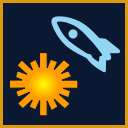
Applications Earth observation satellites (Spy satellites · Weather satellites) · Private spaceflight · Satellite navigation · Space archaeology · Space architecture · Space colonization · Space exploration · Space medicine · Space tourismHuman spaceflight GeneralHazardsMajor projectsApollo · Constellation · Gemini · International Space Station · Mercury · Mir · Shenzhou · Soyuz · Space Shuttle · Voskhod · VostokSpacecraft Destinations Space launch Space agencies Spaceflight lists and timelines General - All spaceflights
- Rocket and missile technology
- Space exploration
- milestones 1957–1969
Human spaceflight General- Manned spacecraft
- (timeline)
- Spaceflights
- 1961–1970
- 1971–1980
- 1981–1990
- 1991–2000
- 2001–2010
- 2011–present
- by program
- Soviet
- Russian
- Mercury
- Gemini
- Apollo
- Shenzhou
- Expeditions
- Spaceflights (manned
- unmanned)
- Spacewalks
- Visitors
- Expeditions
- Spaceflights (manned
- unmanned)
- Spacewalks
- Visitors
- Astronauts (Apollo
- by name
- by year of selection)
- Cosmonauts
- Married couples among space travelers
- Space travelers by name
- Space travelers by nationality
- (timeline)
- Spacewalks and moonwalks (1965–1999
- 2000–present)
- Cumulative spacewalk records
- Spacewalkers
Solar System exploration Earth-orbiting satellites - Climate research
- Communications satellite firsts
- CubeSats
- Earth observation satellites
- (timeline)
- Geosynchronous orbit
- GOES
- Kosmos
- Magnetospheric
- NRO
- TDRS
- USA
Vehicles - Orbital launch systems
- comparison of small lift launch systems
- comparison of medium lift launch systems
- comparison of orbital launch systems
- Sounding rockets
- Spacecraft (unmanned
- manned)
- Upper stages
Launches by rocket type - Ariane
- Atlas
- Black Brant
- Long March
- Proton
- R-7
- Thor and Delta
- Titan
- V-2 tests
Agencies, companies
and facilitiesOther mission lists
and timelinesCategories:
Wikimedia Foundation. 2010.

